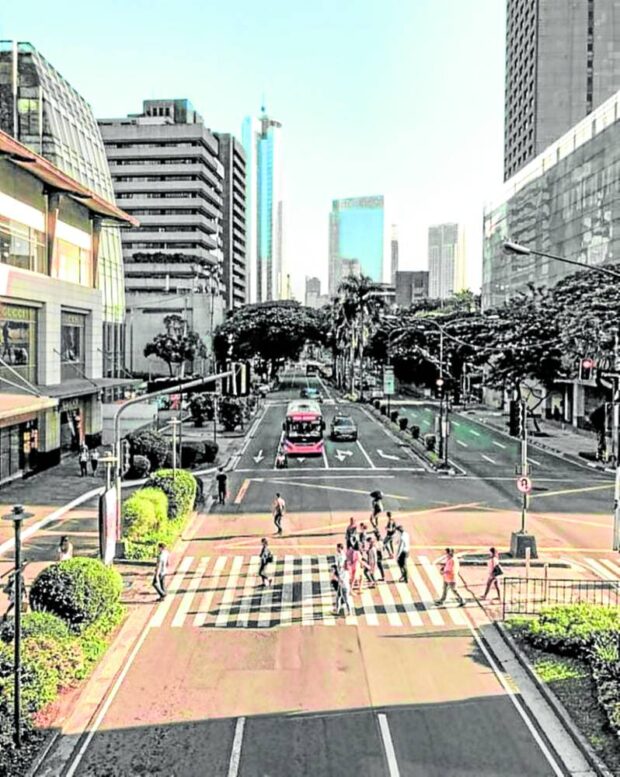
Developing public transport-oriented growth and creating compact and walkable neighbor- hoods (FILE PHOTO)nt provides the opportunity to plan for and invest in the integration of affordable housing. (FILE PHOTO)
The ongoing construction of the North-South Commuter Railway as well as the Mega-Manila Subway will alter the way we move around and the structure of the areas they will serve.
The form and structure of an established city are primarily an outcome of its history—when it proceeded through its major growth phases and the form of transportation that was dominant at that time. For example, most European cities that have been in existence for centuries have a compact core that is suitable for pedestrians and unsuitable for motor vehicle use. Conversely, many American and other cities grew rapidly in the post World War II period, aided by rapidly expanding populations, increasing motor vehicle availability and use, and cheap gasoline.
Expanding urban areas
In the last three to four decades, numerous cities around the world have realized the need to address the financial, social, and environmental problems manifested with expanding urban areas.
Increases in land value provide a revenue source opportunity to return a significant proportion of the cost of public transport developments adjacent to transport-oriented developments. (HTTPS://CDCBUS.COM.AU)
They’ve established policies to mitigate the effects of growing populations, rural migration, urban sprawl, and car dependence. This has been undertaken through informed and deliberate governance strategies to improve and enhance accessibility and mobility, public health and environment, and a response to climate change mitigation and adaptation.
A large number of these cities have realized the benefits from aligning land use policy with transport policy so that high quality urban transport systems integrate with supportive rezoning of land adjacent to transport corridors or around transit stations. Other benefits also include rapid and sustained economic growth and employment and increased property investment.
Integrated urban development, underpinned by public transport and revitalization of land with mixed land uses, brings benefits to the city. (HTTPS://WWW.FACEBOOK.COM/MAKEITMAKATI/)
Research findings from these cities further indicate that the alignment and integration of land use and transport policy has led to a shift in the planning vision from a designation of land use to enabling the realization of the community’s needs and day-to-day functions. Also stressed is the need to maintain strong institutional and governance structures for the successful implementation of urban transformational policies that impact city mobility.
Key findings
Here are the key findings of the research.
First, integrated urban development, underpinned by public transport and revitalization of land with mixed land uses, brings with it triple bottom line (social, economic and environmental) benefits to the city.
Second, developing public transport-oriented growth and creating compact and walkable neighborhoods can reduce car distances traveled, lower traffic congestion and emissions, provide significant health benefits, and stimulate increased productivity.
Meanwhile, increases in land value provide a revenue source opportunity to return a significant proportion of the cost of public transport developments adjacent to transport-oriented developments.
Also, containing the extent of new urban development can assist in minimizing household transport expenditure and in the protection of fringe real estate values.
Transit-oriented urban redevelopment provides the opportunity to plan for and invest in the integration of affordable housing and social housing, infrastructure and services.
And lastly, with the transport sector accounting for nearly 25 percent of greenhouse gas emissions in metropolitan areas worldwide, creation of less car-dependent urban forms is an essential governance and policy response to climate change mitigation and adaptation.
Reenergize older urban areas
The forthcoming operationalization of the North-South Commuter Railway (NSCR), with its planned 40 transit stations between New Clark City in the north and Calamba in the south, presents an enormous opportunity to open new, properly planned mixed-use communities and to reenergize older urban areas. It will not only help decongest Metro Manila but also provide new sites for affordable housing as well as safer and more comfortable communities.
The development of new urban centers and redevelopment of old commercial districts will continue regardless of planning and urban design.
Creation of less car-dependent urban forms is an essential governance and policy response to climate change mitigation and adaptation. (HTTPS://STATIC1.SQUARESPACE.COM)
But the real opportunity presented by the NSCR is to work with the community, the government, planners and design professionals to help shape that process that will transform our cities to ones that can adapt with change and simultaneously provide a livable environment for all its users—from residents, workers, to visitors.
The author is a fellow of the Philippine Institute of Environmental Planners (PIEP), and presently the principal urban planner of CONCEP Inc. He may be reached via nveinsiedel@gmail.com